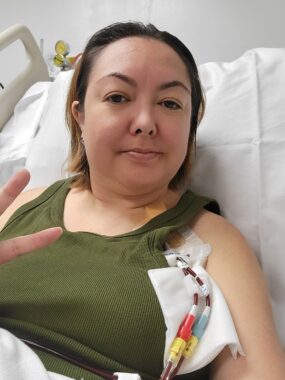My journey with plasma exchange after an NMOSD optic attack
I'm hoping the process will wipe out the last of my vision troubles
Written by |

“What doesn’t kill you makes you stronger,” as they say. Along those lines, my first experience with plasmapheresis for neuromyelitis optica spectrum disorder (NMOSD) was both intense and helpful.
In May, I suffered an optic neuritis attack in my left eye. After five days of intravenous Solu-Medrol (methylprednisolone sodium succinate), my vision returned. I thought I was in the clear, but a month later, my left eye went completely dark. This development worried my neurology team because the attacks had been close together. They administered another five-day round of Solu-Medrol, but this time, it didn’t work. It was time to try plasmapheresis.
Plasmapheresis, also known in the NMOSD community as plasma exchange or PLEX, involves removing plasma from the blood and replacing it with a substitute solution. This process removes harmful antibodies from the bloodstream, reducing inflammation and alleviating symptoms.
The plasmapheresis procedure

Columnist Jennifer van Amerom lies in a hospital bed, with port lines emerging from her chest, awaiting plasmapheresis treatment for NMOSD. (Photo by Jennifer van Amerom)
When my neurologist suggested the procedure, I was apprehensive and daunted by the idea of having my blood removed and filtered. But after a severe NMOSD relapse that left me with significant vision loss, I was out of options. I was told the filtration could be done through intravenous lines in each arm, but if my veins weren’t strong enough, they’d insert a port into my chest. Knowing my poor veins, I expected the port.
On my first day, in fact, the hospital fit me in right away to insert that port. This general surgery involved sedating me and freezing the site area with lidocaine needles. As I was wheeled into surgery, though, I started to panic. Thankfully, the nurses let me wear my smart sunglasses, which played music.
But despite increased sedation, I was aware enough to have an epic panic attack as the doctor prepared the surgical site. Eventually, I barely remembered the lyrics to my favorite Taylor Swift song as the sedation took effect.
When I woke up, I had two lines sticking out of my chest, with about 2 feet of cabling, like the lines behind a TV, hidden inside my body. That caused discomfort and bruising. But after I received that first round of plasma exchange, I was allowed to go home.
My neurology team wanted me to complete seven rounds of plasma exchange as an outpatient. The lines thus stayed in my chest for three weeks, longer than usual because of scheduling challenges with weekends and a holiday. The best results occur with treatments every other day, but they can also happen two days in a row. I felt nauseous and vomited after every treatment, even with anti-nausea medication.

A centrifuge machine extracts old plasma and returns new plasma. (Photo by Jennifer van Amerom)
After completing the series of treatments, I began to notice significant improvements. My vision started to return, though not fully. Still, positive results can come weeks or even months later. While plasmapheresis isn’t a cure for NMOSD, it’s been a crucial part of my treatment plan this time. But I hope I never undergo it again.
After my final round of plasma exchange, the nurses removed the port. They warned me that removing the sutures would be the most difficult part. One of them was double-knotted, causing intense pain as they removed it and the lines from my chest. That was more traumatizing than when the port was inserted.
The emotional aspect of dealing with NMOSD and undergoing plasmapheresis cannot be overlooked. Over the past two months, I’ve had moments of fear, anxiety, and uncertainty. This treatment was traumatizing. Now, a week after the lines were removed, the hole in my chest is still slow to heal.
But I remain hopeful because I have to be. Plasmapheresis was a last resort, so I hope my vision fully returns. If so, then it was worth the treatment.
Note: Neuromyelitis News is strictly a news and information website about the disease. It does not provide medical advice, diagnosis, or treatment. This content is not intended to be a substitute for professional medical advice, diagnosis, or treatment. Always seek the advice of your physician or other qualified health providers with any questions you may have regarding a medical condition. Never disregard professional medical advice or delay in seeking it because of something you have read on this website. The opinions expressed in this column are not those of Neuromyelitis News or its parent company, Bionews, and are intended to spark discussion about issues pertaining to neuromyelitis optica spectrum disorder.







Leave a comment
Fill in the required fields to post. Your email address will not be published.